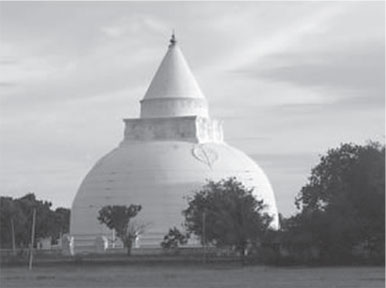Tissa Maha Vihara - the great stupa of the South
by Rupa BANDUWARDENA
Sakyamuni Siddhartha Gautama Buddha, after attaining Enlightenment
and realising the gift of eternal truth, was mainly concerned with
spreading the message of the Dhamma to humanity for the welfare and
happiness of all living beings.
He had predicted that His supreme gift to the universe will be
welcomed, protected and adorned in Sri Lanka. True to His vision and
foresight, after the introduction of the Dhamma, this paradise isle
became a Dhammadweepa.
 The kingdom of Devanampiyatissa became the cradle of Buddhism and in
addition to the doctrine, the associated forms of arts, sculpture and
architecture reached all four corners of the island. The kingdom of Devanampiyatissa became the cradle of Buddhism and in
addition to the doctrine, the associated forms of arts, sculpture and
architecture reached all four corners of the island.
The royalty utilised these arts to create magnificent Buddhist
structures, reflecting the proud culture of the island. They are a
tribute to the rulers' devotion to the new faith.
Tissa Maha Vihara is one such creation in the deep South which
displays the island's proud history and cultural heritage. Going back to
its origin, the great stupa reveals the amazing historical background of
Buddhist traditions, ancient chronicles and archaeological evidence and
shows that it was the largest chaitya in the island at the time, built
by King Kavantissa as far back as the Third Century BC, in the area
known as Magama, one of the principal settlements in the region of
Ruhuna.
Powerful monarch
It is traditionally credited to Kavantissa, a powerful monarch and
sovereign ruler whose reign was marked by very important events.
Mahanaga, the brother of King Devanampiyatissa, was appointed the
sub-king (Yuwaraja) of Ruhuna.
History records that Ruhuna was a very prosperous area then. The
great stupa was built by Mahanaga's grandson - King Kavantissa who is
further distinguished as the father of King Dutugemunu, the national
hero, the first king to liberate and unify the island.
One is reminded of Dutugemunu's mother, the charming Viharamaha Devi
and the legend of the tsunami. The first recorded tsunami occurred in
Kelaniya and compelled the king to send his daughter afloat to sea, to
save his subjects. The ship carrying the beautiful princess landed in
Magampura where she became the queen of King Kavantissa. A large statue
of Queen Viharamaha Devi is found in the premises of the great stupa,
reminding one of the glorious past of Ruhuna.
Splendid location
Historically, Tissamaharama's importance was as a prosperous
agricultural centre. Endless acres of paddy land tell us of the ancient
splendour of the area: of the hard work of the people and the
performance of the royalty.
Tissa Weva, believed to be one of the earliest reservoirs, built by
King Kavantissa, giving life to the green surroundings, spreads its
grace as a royal construction. Everybody saw it as a city of abundance
with the great stupa standing in the centre, playing a dominant role in
the religious life of the ancient Sinhala peole as well as the present
residents.
Unique in human history, much care has been taken to ensure the
strength right round the stupa; walls of great strength and height had
enclosed the chaithya. Its architecture is certainly something you
wouldn't find anywhere else in the region. It bears a strong resemblance
to the stupas built in Anuradhapura.
The stupa is of a massive height, and reaches up to the blue sky with
clouds floating around it. This is an impressive and majestic sight. Its
cone-shaped top with brick and stone architecture at the bottom could be
seen from afar.
The chaitya, enshrining the Buddha's sacred relics, gives one a
feeling of piety and serenity.
There had been gates on all four sides, the outer area is covered
with paddy fields and there is a cool breeze blowing across. Thanks to
the royal patronage in early history, today this sacred site has become
a place of worship not to be missed by Lankan Buddhists.
In fact, the stupa draws pilgrims from all four corners of the
island.
This is a sacred venue in which the people of the South take much
pride and remains a notable ornament in Southern Lanka, possessing the
most sacred Lalata Dhathu of the Buddha. There is a special Pali stanza
to venerate and worship the chaitya.
|

